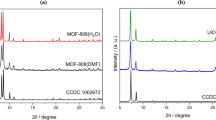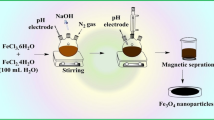Abstract
In the present work, rGO/MoS2/Fe3O4 nanocomposite was synthesized and after confirmation of the structure by FTIR, XRD, and FESEM techniques, its performance as nanosorbent was investigated for the removal of fenitrothion pesticide from the aqueous media. The parameters affecting the removal process including agitation time, pH of the reaction medium, adsorbent content, initial analyte concentration as well as desorption parameters were investigated and optimized. Under optimum conditions (pH = 7, adsorbent amount: 30 mg, adsorption and desorption time: 5 min, eluent type and volume: 0.01 M ethanol-acetic acid and 4 mL), the synthesized adsorbent was able to remove fenitrothion pesticide up to 98% with an adsorption capacity of 33.4 mg/g. By investigation of the line equation and the correlation coefficient value, it was found that the adsorption process, in this study, follows the Langmuir model.







Similar content being viewed by others
References
Zhao YY, Pei YS. Risk evaluation of groundwater pollution by pesticides in China: a short review. Procedia Environ Sci. 2012;13:1739–47.
Saeidi M, Naeimi A, Komeili M. Magnetite nanoparticles coated with methoxy polyethylene glycol as an efficient adsorbent of diazinon pesticide from water. AET. 2016;1:25–31.
Ikeura H, Kobayashi F, Tamaki M. Removal of residual pesticide, fenitrothion, in vegetables by using ozone microbubbles generated by different methods. J Food Eng. 2011;103(3):345–9.
Bonnechère A, Hanot V, Jolie R, Hendrickx M, Bragard C, Bedoret T, et al. Effect of household and industrial processing on levels of five pesticide residues and two degradation products in spinach. Food Control. 2012;25:397–406.
Shah NS, Khan JA, Nawaz S, Ismail M, Khan K, Khan HM. Kinetic and mechanism investigation on the gamma irradiation induced degradation of endosulfan sulfate. Chemosphere. 2015;121:18–25.
Khan JA, Shah NS, Khan HM. Decomposition of atrazine by ionizing radiation: kinetics, degradation pathways and influence of radical scavengers. Sep Purif Technol. 2015;15:140–7.
WHO. Background document for development of WHO Guidelines for Drinking-water Quality, 1995.
IPCS. Fenitrothion. Geneva, World Health Organization, international Programme on chemical safety (environmental health criteria 133);1992.
Malakootian M, Shahesmaeili A, Faraji M, Amiri H, Silva MS. Advanced oxidation processes for the removal of organophosphorus pesticides in aqueous matrices: a systematic review and meta-analysis. Process Saf Environ. 2020;134:292–307.
Liu G, Li L, Huang X, Zheng S, Xu X, Liu Z, et al. Adsorption and removal of organophosphorus pesticides from environmental water and soil samples by using magnetic multi-walled carbon nanotubes@ organic framework ZIF8. J Mater Sci. 2018;53:10772–83.
Nodeh HR, Ibrahim WAW, Kamboh MA, Sanagi MM. New magnetic graphenebased inorganic–organic solgel hybrid nanocomposite for simultaneous analysis of polar and non-polar organophosphorus pesticides from water samples using solid-phase extraction. Chemosphere. 2017;166:21–30.
Heidarinejad Z, Rahmanian O, Fazlzadeh M, Heidari M. Enhancement of methylene blue adsorption onto activated carbon prepared from date press cake by low frequency ultrasound. J Mol Liq. 2018;264:591–9.
Dehghani MH, Mahvi AH, Rastkari N, Saeedi R, Nazmara S, Iravani E. Adsorption of bisphenol a (BPA) from aqueous solutions by carbon nanotubes: kinetic and equilibrium studies. Desalin Water Treat. 2015;54(1):84–92.
Dehghani MH, Kamalian S, Shayeghi M, Yousefi M, Heidarinejad Z, Agarwal S, et al. High-performance removal of diazinon pesticide from water using multi-walled carbon nanotubes. Microchem J. 2019;145:486–91.
Nayeri D, Mousavi SA. Dye removal from water and wastewater by nanosized metal oxides - modified activated carbon: a review on recent researches. J Environ Health Sci Eng. 2020;18:1671–89.
Theerthagiri J, Senthil RA, Senthil Kumar B, Reddy Poluc A, Madhavan J, Ashokkumar M. Recent advances in MoS2 nanostructured materials for energy and environmental applications – a review. J Solid State Chem. 2017;252:43–71.
Assis AMAD, Silva KS, Araújo MKS, Sales DCS, Ferreirac MC, Araújo ACV, et al. Thermal synthesis of rGO and rGO-Co3O4and their application asadsorbents for anionic dye removal. Colloids Surf A Physicochem Eng Asp. 2020;599:124837.
Hummers WS Jr, Offeman RE. Preparation of graphitic oxide. J Am Chem Soc. 1958;80(6):1339.
Tizro N, Moniri E, Saeb K, Panahi HA, Ardakani SS. Preparation and application of grafted β-cyclodextrin/thermo-sensitive polymer onto modified Fe3O4@ SiO2 nano-particles for fenitrothion elimination from aqueous solution. Microchem J. 2019;145:59–67.
Maddah B, Shamsi J. Extraction and preconcentration of trace amounts of diazinon and fenitrothion from environmental water by magnetite octadecylsilane nanoparticles. J Chromatog A. 2012;1256:40–5.
Mohammadi S, Ebrahimi M, Khoshnood RS. Magnetic solid-phase extraction based on CoFe2O4 magnetic nanoparticles for the determination of diazinon and fenitrothion in aqueous samples. Bulg Chem Commun. 2017;1:69–72.
Bazmandegan-Shamili A, Dadfarnia S, Shabani AM, Moghadam MR, Saeidi M. Multi simplex optimization of the dispersive solid-phase microextraction and determination of fenitrothion by magnetic molecularly imprinted polymer and high-performance liquid chromatography. J Iri Chem Soc. 2018;15(5):1181–9.
Maddah B, Hasanzadeh M. Fe3O4/CNT magnetic nanocomposites as adsorbents to remove organophosphorus pesticides from environmental water. Int J Nanosci Nanotechnol. 2017;13(2):139–49.
Author information
Authors and Affiliations
Corresponding author
Ethics declarations
Conflict of interest
The authors declare that they have no conflict of interest.
Additional information
Publisher’s note
Springer Nature remains neutral with regard to jurisdictional claims in published maps and institutional affiliations.
Rights and permissions
About this article
Cite this article
Mangeli, A., Mostafavi, A., Shamspur, T. et al. Decontamination of fenitrothion from aqueous solutions using rGO/MoS2/Fe3O4 magnetic nanosorbent: synthesis, characterization and removal application. J Environ Health Sci Engineer 19, 1505–1511 (2021). https://doi.org/10.1007/s40201-021-00706-w
Received:
Accepted:
Published:
Issue Date:
DOI: https://doi.org/10.1007/s40201-021-00706-w




